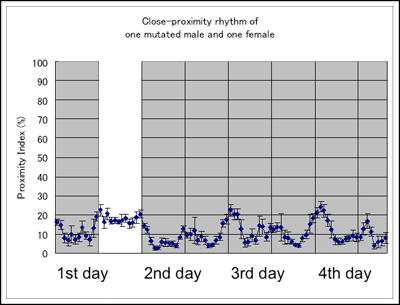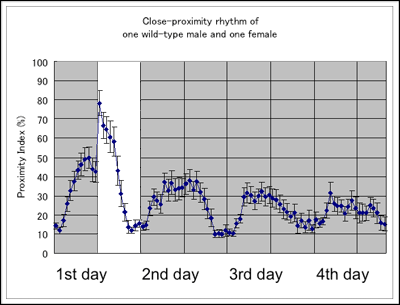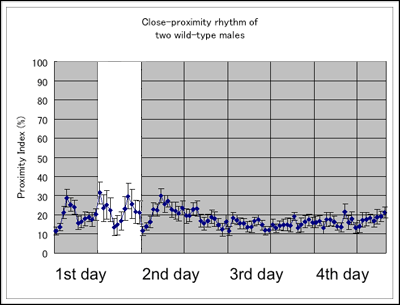Norio Ishida (Prime Senior Researcher) and Yasutaka Hamasaka (AIST Postdoctoral Researcher), the Biomedical Research Institute (Director: Masanao Oda) of the National Institute of Advanced Industrial Science and Technology (AIST; President: Tamotsu Nomakuchi), and Takahiro Suzuki (Contract Researcher), the Japan Industrial Technology Association (President: Mototsugu Ito), have clarified that the evening oscillator, one of biological clocks, regulates courtship behavior in Drosophila by employing molecular biological techniques.
Good sleep and interest in the opposite sex are important factors for the maintenance of brain health (slowed aging) in living things and biological clocks are deeply involved in this mechanism. Drosophila is a suitable model organism for the study of biological clocks and recent studies have demonstrated that biological clocks regulate the rhythm of the courtship behavior observed in males in which they follow the females (close-proximity rhythm). In this study, we have identified the center in the brain that was responsible for the close-proximity rhythm in Drosophila and clarified that the biological clock controlling this rhythm was located at a brain region known as the "evening oscillator."
These results were published online in Genes to Cells, an English language journal of the Molecular Biology Society of Japan, on November 28, 2010 and will be presented at the workshop titled "How Behavior is Governed by Genes" during the joint meeting of the 33rd Annual Meeting of the Molecular Biology Society of Japan and the 83rd Annual Meeting of the Japanese Biochemical Society on December 8, 2010 in Kobe, Japan.
 |
|
Figure 1: Cross-section of a Drosophila brain |
Good sleep is useful for the maintenance of brain health. Biological clocks, i.e. clock genes, are deeply involved in the molecular mechanism of sleep. From a biological aspect, maintaining interest in the opposite sex is an especially important factor. Moreover, biological clocks play important roles in maintaining brain health, as they are closely involved with not only sleep, but also reproductive behavior. Therefore, the biological clocks are expected to contribute to the clarification of the basic molecular mechanisms of the slowed aging and the health of the human brain.
Using a wide variety of living organisms, AIST has conducted the research on the functions and mechanisms of biological clocks. Drosophila, which is an ideal model organism for biological clock studies, displays various rhythms of courtship behavior shown to females by males in the process of achieving reproduction (Fig. 2). We have clarified that clock genes regulate mating in Drosophila and that the circadian rhythm that enables females to accept males is involved in the final achievement of mating (Proceedings of the National Academy of Sciences of the United States of America, 98, 9221–9225, 2001). We also developed an instrument to measure close-proximity rhythm, i.e. the rhythm of behavior of a male following a female when one male and one female were put in a Petri dish. In addition, we recently clarified that males take the lead in the close-proximity rhythm, characterized by courtship behavior shown to females by males before the achievement of mating, and we found that circadian clocks control the close-proximity rhythm. In the present study, by using the instrument in combination with molecular biological techniques, we identified the location of the biological clocks responsible for this close-proximity rhythm in the Drosophila brain and clarified its molecular neural mechanism.
 |
|
Figure 2: Close-proximity rhythm of Drosophila |
Two Drosophilae were set into a Petri dish and observed to determine whether they came within 5 mm of each other every 10 seconds. Then the results were totaled per hour (10 seconds x 360), the ratio of the hours of close-proximity behavior was calculated, and close-proximity rhythms for one day including day and night and three constant dark days were measured (Fig. 3). Although two Drosophila males in the Petri dish showed no active courtship behavior (Fig. 3, top), one male and one female in the Petri dish clearly showed the close-proximity rhythm (Fig. 3, center). In an experiment using a Drosophila male with a mutated clock gene, Period, and a Drosophila female, the close-proximity rhythm disappeared (Fig. 3, bottom). This finding suggested the close-proximity rhythm is affected by clock genes in Drosophila.
 |
 |
 |
Figure 3: Close-proximity rhythms was measured with two Drosophilae in a Petri dish at for 12hr-night and 12hr-light and constant dark for three days
The results of two males (top), one male and one female (center), and a male with clock gene mutation and a normal female (bottom) are shown. |
Then, we attempted to identify the center in the brain that regulated this close-proximity rhythm. Thanks to sophisticated methods for the molecular biological analysis of Drosophila, we can express clock genes or suppress their functions at various brain regions. We prepared Drosophila males in which apoptosis-inducing genes were expressed at the brain region of the evening oscillator or morning oscillator, or at both brain regions, and measured the close-proximity rhythms using each of these males and a normal female. By taking this approach, we could figure out which brain region is the center that regulates the close-proximity rhythm. As illustrated in Fig. 4, the close-proximity rhythm disappeared when the nerve cells at the brain region of the evening oscillator were destroyed.
 |
|
Figure 4: Close-proximity rhythms after the lesion of the nerve cells at the brain regions of the evening oscillator and the morning oscillator |
Based on these experiments alone, however, we cannot answer the question of whether the brain region of the evening oscillator is a oscillator or a mere transit point. Thus, we used genetic engineering to block only the clock functions at the brain regions without inducing apoptosis, and we then measured the close-proximity rhythms again. In these experiments, we confirmed that the close-proximity rhythm declined only after blocking the clock functions of nerve cells acting specifically on the evening oscillator, even if not all nerve cells at the brain region of the evening oscillator were destroyed. These experiments clarified that the biological clock that regulates the close-proximity rhythm depends on the evening oscillator.
We will clarify, at the genetic level, the molecules that are expressed in site-specific and time-specific manners at the center of the evening oscillator in the Drosophila brain, and will elucidate the functions of these molecules regarding sexual behavior. Furthermore, we would like to clarify the communication pathway from the clock center in the brain to the neural network of sexual behavior and to draw a brain map. We will also use imaging technology to visualize the brain neural network involved in the rhythm of the mating activity of males and females.